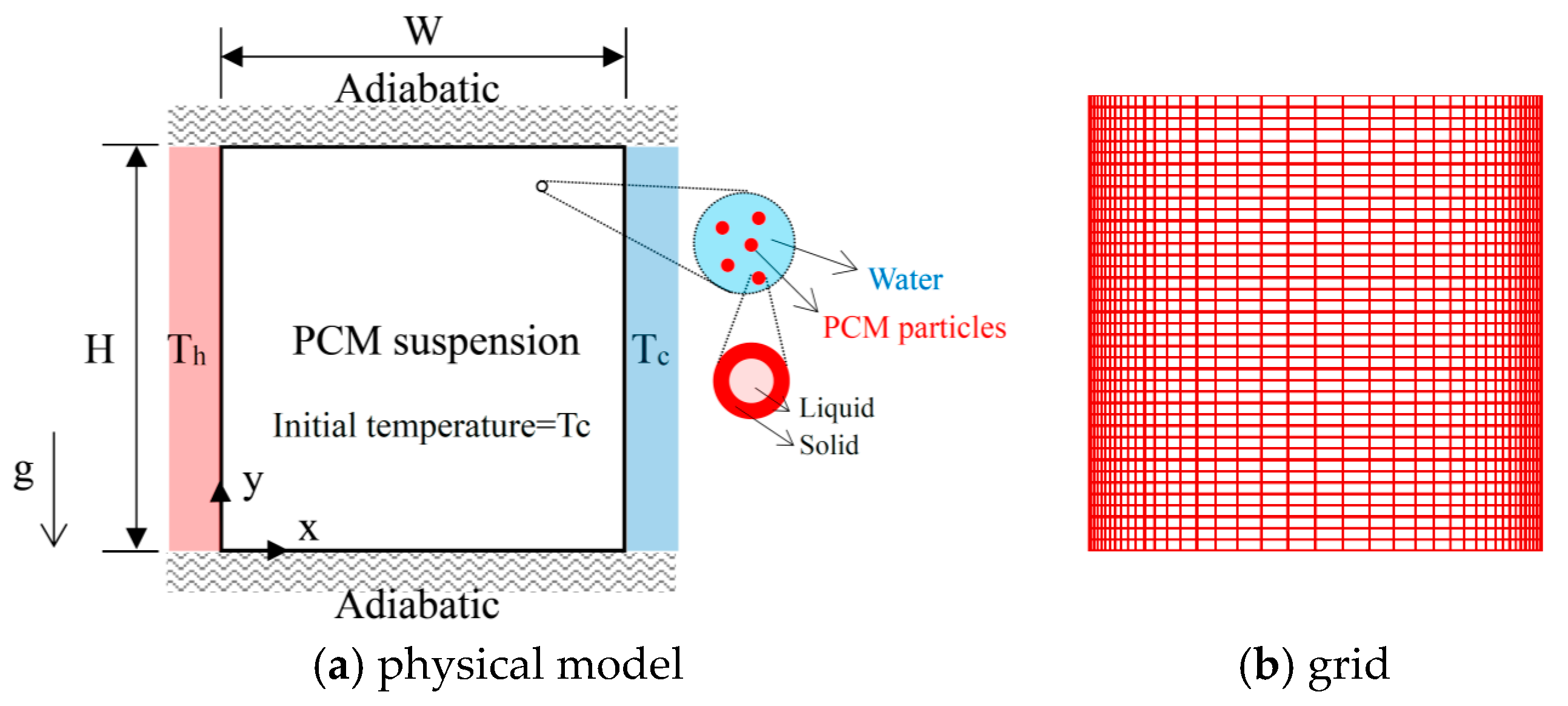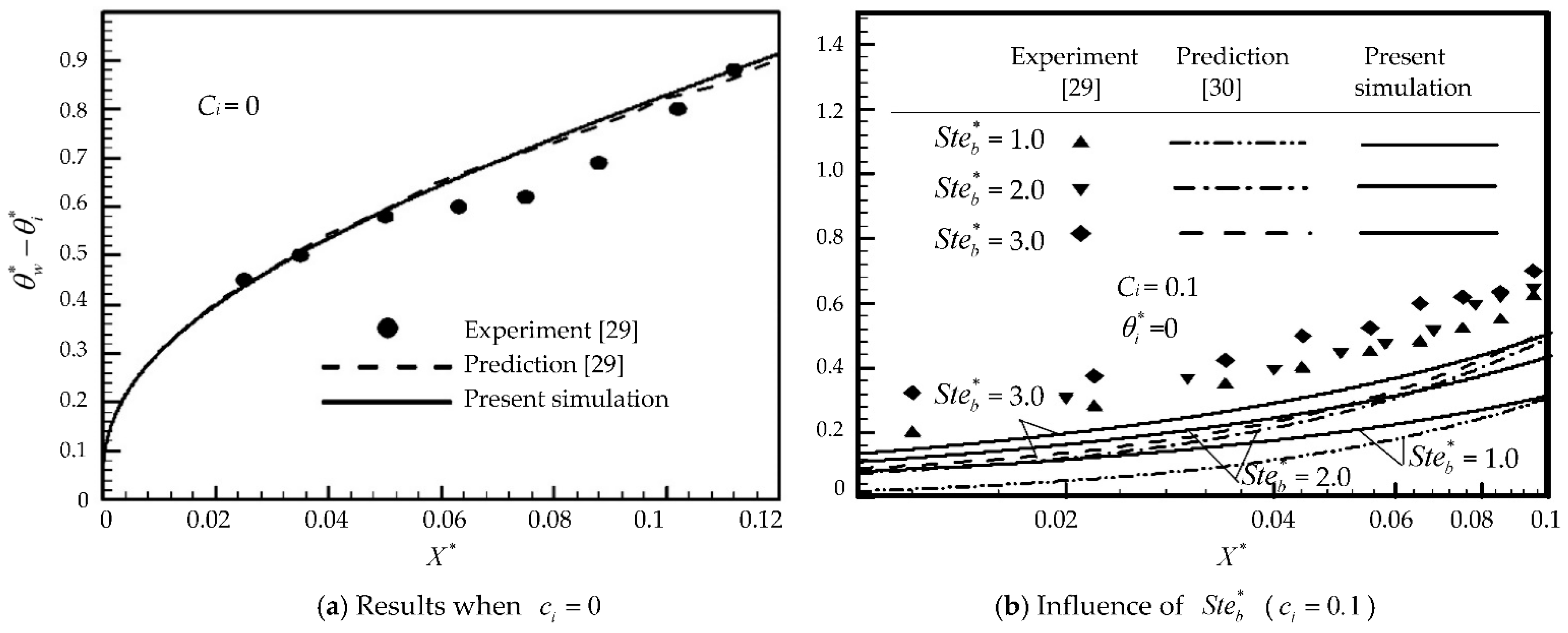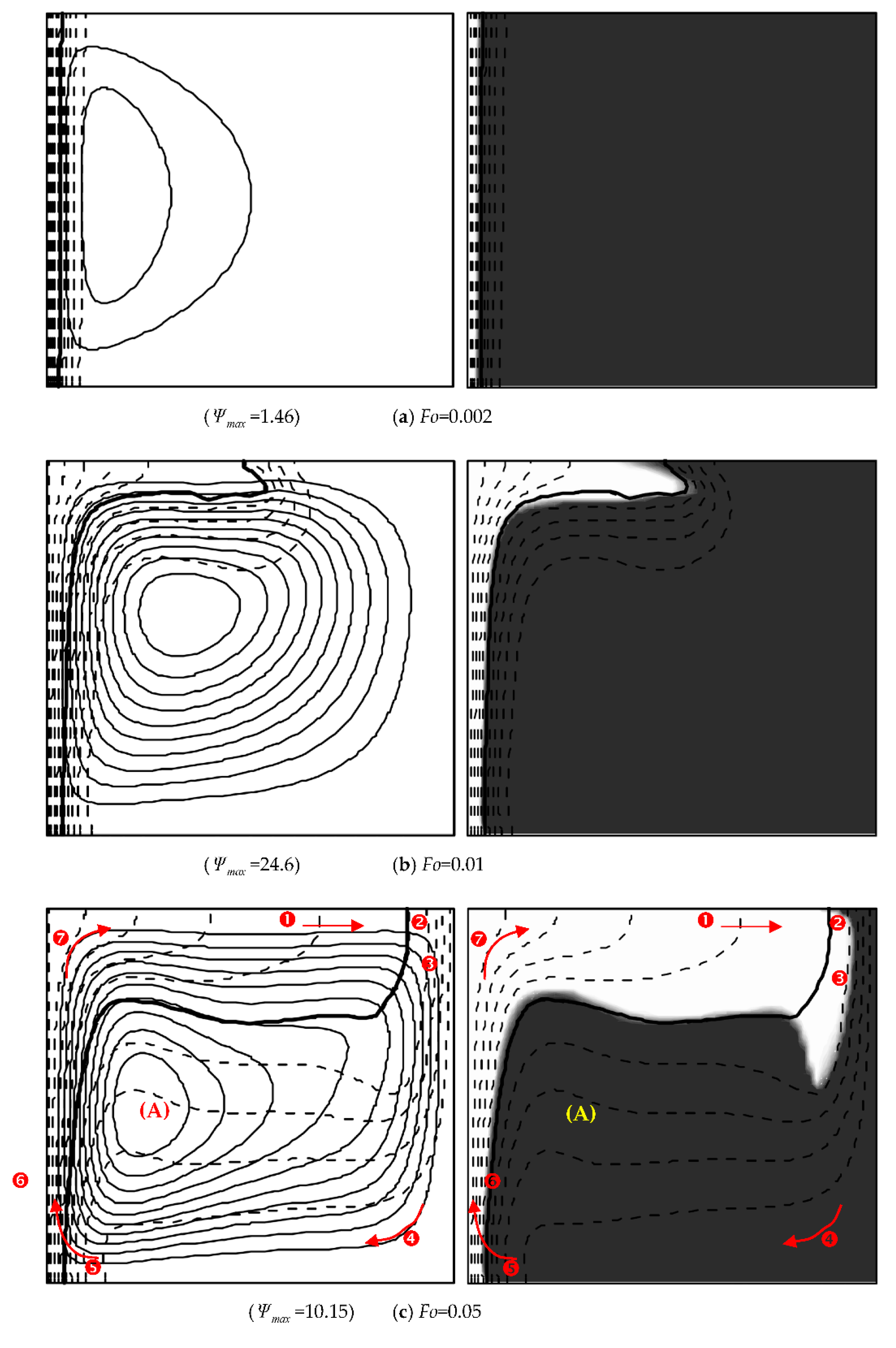Heat Transfer by Natural Convection in a Square Enclosure Containing PCM Suspensions
Abstract
1. Introduction
2. Problem Formulation
- Suspended PCM particles are rigid spheres of a uniform size, whose size is much smaller than the characteristic dimension of flow.
- PCM suspension is a dilute solution and is treated as a Newtonian fluid.
- The dispersed PCM particles are neutrally buoyant in the mixture.
- The flow of the PCM suspension is a two-dimensional laminar flow.
- Except for the phase change process of particles, the hypothesis of local thermal equilibrium between the particles and base fluid is established.
- The melting and freezing of the PCM particles occur at a fixed temperature.
- There are no chemical or nuclear reactions between the particles and the fluid.
- In the initial stage, the PCM particles are uniformly suspended in the fluid, which is a two-phase fluid.
- The interface effect of the surfactants coated on the PCM is ignored.
- In addition to the buoyancy caused by the density differences, the thermal properties of the fluid can be regarded as constants.
- The density change associated with the solid–liquid phase change in the particles is negligible.
- The thermal radiation and viscous dissipation in the flow are neglected.
- The relative velocity between the particles and the fluid is quite low compared with the overall solution velocity, and can be ignored.
- when ; b = 3, m = 1.5;
- when ; b = 1.8, m = 0.183;
- when ; b = 3, m = 0.09091.
3. Numerical Method
- (1)
- The inlet temperature is uniform.
- (2)
- The flow field of the fluid is a two-dimensional, hydrodynamically fully developed laminar flow.
- (3)
- The fluid was regarded as a Newtonian fluid.
- (4)
- Except for the heat conductivity, which varies with the flow field, the bulk properties of the fluid are homogeneous and fixed.
- (5)
- The concentration distribution is uniform.
- (6)
- The buoyancy caused by the temperature differences is negligible.
- (7)
- The temperature field is axially symmetric.
4. Results and Discussion
4.1. Transient Evolution
 in Figure 4c) and expand the melting range to the right (
in Figure 4c) and expand the melting range to the right ( ). From the figures on the right panel, the PCM inside the particles at both
). From the figures on the right panel, the PCM inside the particles at both 
 is liquid. The flow turns downward as it approaches the cold wall on the right side (
is liquid. The flow turns downward as it approaches the cold wall on the right side ( ). During the flow process, the PCM inside the particles is gradually cooled to solid. The downward flowing PCM suspension turns to the left under the influence of the wall below (
). During the flow process, the PCM inside the particles is gradually cooled to solid. The downward flowing PCM suspension turns to the left under the influence of the wall below ( ), then it is directed upward by the thermal buoyancy near the hot wall on the left (
), then it is directed upward by the thermal buoyancy near the hot wall on the left ( ). Finally, it returns to the top region (
). Finally, it returns to the top region ( ) to form the main circulation.
) to form the main circulation.4.2. Steady-State Results
5. Conclusions
- Under the condition of high , high , and low Ste, the transient and the steady-state values of the Nusselt number () are high, and the time required to reach steady-state is decreased.
- With increasing Sb, increases first then decreases, and there is a local optimum . Within the discussed parameter ranges, when , the maximum is 1.20, which occurs when and Sb = 0.8; when , the maximum is 2.89, which occurs when and Sb = 0.5; and when , the maximum is 5.13, which occurs when and Sb = 0.5.
- As increases, decreases; moreover, as increases, oscillatory natural convection is induced by higher Stes; in other words, the low latent heat of the PCM can induce oscillatory natural convection under high . This phenomenon of oscillatory natural convection has not yet been mentioned in the literature.
Author Contributions
Funding
Acknowledgments
Conflicts of Interest
Nomenclature
| A | Surface area of the PCM particle |
| AR | Aspect ratio of the rectangular enclosure, H/W |
| Bip | Biot number of a PCM particle, |
| c | Mass fraction of PCM particles |
| ca | Concentration of species a |
| Initial mass fraction of PCM particles | |
| Volumetric fraction of PCM particles, | |
| C | Dimensionless mass fraction of PCM particles, c/ci |
| Cp | Specific heat |
| dp | Average diameter of PCM particles |
| D | Mass diffusivity or diffusion coefficient |
| Dp | Dimensionless average particle size of PCM particles, Dp/W |
| E | Error |
| Fo | Fourier number, |
| Modified Fourier number, | |
| g | Acceleration due to gravity |
| h | Convection heat transfer coefficient |
| Latent heat of fusion | |
| H | Height of the rectangular enclosure |
| i | Grid point at the x-axis |
| j | Grid point at the y-axis |
| k | Thermal conductivity |
| Le | Lewis number, |
| N | Buoyancy ratio of mass-to-heat transfer, |
| Nu | Local Nusselt number |
| Average Nusselt number | |
| p | Pressure |
| P | Dimensionless pressure, p/ |
| Pe | Peclet number, |
| Pr | Prandtl number, |
| Heating flux | |
| R | Radical direction |
| Thermal Raleigh number, | |
| Tube radius | |
| Radius of a PCM particle | |
| Sb | Subcooling factor, |
| Ste | Stefan number, |
| Modified Stefan number, | |
| t | Time |
| T | Temperature |
| u | Velocity in the X-direction |
| Average flow velocity of the fluid in the tube | |
| U | Dimensionless velocity in the X-direction, |
| Modified dimensionless velocity in the X-direction, | |
| Characteristic velocity, | |
| v | Velocity in the Y-direction |
| V | Dimensionless velocity in the Y-direction, |
| W | Width of a rectangular enclosure |
| X | Dimensionless x-coordinate, x/W |
| Modified dimensionless x-coordinate, | |
| Y | Dimensionless y-coordinate, y/W |
| Difference between the melting and freezing points of the PCM | |
| Greeksymbols | |
| Thermal diffusivity | |
| Concentration expansion coefficient () | |
| Thermal expansion coefficient | |
| Kinematic viscosity | |
| Variable under investigation | |
| Dimensionless temperature, | |
| Modified dimensionless temperature, | |
| Density | |
| Vorticity | |
| Heat transfer time lag of the PCM particles | |
| Dimensionless heat transfer time lag of the PCM particles, | |
| Liquid-phase volume fraction of the PCM particles | |
| Stream function | |
| Dimensionless tube diameter, | |
| Volume of a PCM particle | |
| Supercooling factor, | |
| Modified supercooling factor, | |
| Comparison criteria | |
| Subscripts | |
| b | Bulk fluid |
| c | Cooled wall |
| f | Base fluid (water) |
| h | Heated wall |
| i | Inside |
| Liquid phase of PCM | |
| m | Melting point |
| m1, m2 | Different grid points |
| p | PCM particle |
| pcm | Phase change materials |
| T | Properties based on temperature |
| s | Solid phase of PCM |
| w | Water, wall |
| Superscripts | |
| Averaged quantity | |
| m | Number of iterations |
| n | Number of time steps (iteration advances) |
References
- Eisapour, A.H.; Eisapour, M.; Hosseini, M.J.; Shafaghat, A.H.; Sardari, P.T.; Ranjbar, A.A. Toward a highly efficient photovoltaic thermal module: Energy and exergy analysis. Renew Energy 2021, 169, 1351–1372. [Google Scholar] [CrossRef]
- Wijayanta, A.T.; Yaningsih, I.; Aziz, M.; Miyazaki, T.; Koyama, S. Double-sided delta-wing tape inserts to enhance convective heat transfer and fluid flow characteristics of a double-pipe heat exchanger. Appl. Therm. Eng. 2018, 145, 27–37. [Google Scholar] [CrossRef]
- Liu, G.; Yang, C.; Zhang, J.; Zong, H.; Xu, B.; Qian, J.-y. Internal Flow Analysis of a Heat Transfer Enhanced Tube with a Segmented Twisted Tape Insert. Energies 2020, 13, 207. [Google Scholar] [CrossRef]
- Muruganandam, D.; Jayapriya, J.; Ramakrishnan, G.; Puthilibai, G.; Karthick, P.; Sudhakar, M. Enhancing heat transfer rate in heat exchanger using nano particles of the natural Glay. Mater. Today Proc. 2020, 33, 4402–4407. [Google Scholar] [CrossRef]
- Ghalambaz, M.; Shirivand, H.; Ayoubloo, K.A.; Mehryan, S.A.M.; Younis, O.; Talebizadehsardari, P.; Yaïci, W. The Thermal Charging Performance of Finned Conical Thermal Storage System Filled with Nano-Enhanced Phase Change Material. Molecules 2021, 26, 1605. [Google Scholar] [CrossRef]
- Eisapour, M.; Eisapour, A.H.; Hosseini, M.J.; Talebizadehsardari, P. Exergy and energy analysis of wavy tubes photovoltaic-thermal systems using microencapsulated PCM nano-slurry coolant fluid. Appl. Energy 2020, 266, 114849. [Google Scholar] [CrossRef]
- Peng, G.; Dou, G.; Hu, Y.; Sun, Y.; Chen, Z. Phase change material (PCM) microcapsules for thermal energy storage. Adv. Polym. Technol. 2020, 2020, 1–20. [Google Scholar] [CrossRef]
- Ho, C.J.; Hsu, H.I.; Ho, T.A.; Lai, C.M. Thermal performance of a vertical U-shaped thermosyphon containing a phase-change material suspension fluid. Energies 2017, 10, 974. [Google Scholar] [CrossRef]
- Ho, C.J.; Lee, C.Y.; Yamada, M. Experiments on laminar cooling characteristics of a phase change nanofluid flow through an iso-flux heated circular tube. Int. J. Heat Mass Transf. 2018, 118, 1307–1315. [Google Scholar] [CrossRef]
- Ren, Q.; Guo, P.; Zhu, J. Thermal management of electronic devices using pin-fin based cascade microencapsulated PCM/expanded graphite composite. Int. J. Heat Mass Transf. 2020, 149, 119199. [Google Scholar] [CrossRef]
- Katz, L. Natural Convection Heat Transfer with Fluids Using Suspended Particles Which Undergo Phase Change. Ph.D. Dissertation, Massachusetts Institute of Technology, Cambridge, MA, USA, 1967. [Google Scholar]
- Datta, P.; Sengupta, S.; Roy, S.K. Natural convection heat transfer in an enclosure with suspensions of microencapsulated phase change materials. Am. Soc. Mech. Eng. Heat Transf. Div. 1992, 204, 133–144. [Google Scholar]
- Charunkyakorn, P.; Sengupta, S.; Roy, S.K. Forced Convective Heat Transfer in Microencapsulated Phase Change Material Slurries: Flow in Circular Ducts. Int. J. Heat Mass Transf. 1991, 34, 819–833. [Google Scholar] [CrossRef]
- Rostami, S.; Afrand, M.; Shahsavar, A.; Sheikholeslami, M.; Kalbasi, R.; Aghakhani, S.; Shadloo, M.S.; Oztop, H.F. A review of melting and freezing processes of PCM/nano-PCM and their application in energy storage. Energy 2020, 211, 118698. [Google Scholar] [CrossRef]
- Huang, X.; Alva, G.; Jia, Y.; Fang, G. Morphological characterization and applications of phase change materials in thermal energy storage: A review. Renew. Sustain. Energy Rev. 2017, 72, 128–145. [Google Scholar] [CrossRef]
- Dardir, M.; Panchabikesan, K.; Haghighat, F.; El Mankibi, M.; Yuan, Y. Opportunities and challenges of PCM-to-air heat exchangers (PAHXs) for building free cooling applications—A comprehensive review. J. Energy Storage 2019, 22, 157–175. [Google Scholar] [CrossRef]
- Rathore, P.K.S.; Shukla, S.K.; Gupta, N.K. Potential of microencapsulated PCM for energy savings in buildings: A critical review. Sustain. Cities Soc. 2020, 53, 101884. [Google Scholar] [CrossRef]
- Moreno, P.; Solé, C.; Castell, A.; Cabeza, L.F. The use of phase change materials in domestic heat pump and air-conditioning systems for short term storage: A review. Renew. Sustain. Energy Rev. 2014, 39, 1–13. [Google Scholar] [CrossRef]
- Ali, H.M.; Ashraf, M.J.; Giovannelli, A.; Irfan, M.; Irshad, T.B.; Hamid, H.M.; Hassan, F.; Arshad, A. Thermal management of electronics: An experimental analysis of triangular, rectangular and circular pin-fin heat sinks for various PCMs. Int. J. Heat Mass Transf. 2018, 123, 272–284. [Google Scholar] [CrossRef]
- Ho, C.J. A continuum model for transport phenomena in convective flow of solid–liquid phase change material suspensions. Appl. Math. Model. 2005, 29, 805–817. [Google Scholar] [CrossRef]
- Ho, C.J.; Chen, C.; Lai, C.M. The effects of geometric parameters on the thermal performance of a rectangular natural circulation loop containing PCM suspensions. Numer. Heat Transf. A Appl. 2016, 70, 1313–1329. [Google Scholar] [CrossRef]
- Alehosseini, E.; Jafari, S.M. Micro/nano-encapsulated phase change materials (PCMs) as emerging materials for the food industry. Trends Food Sci. Technol. 2019, 91, 116–128. [Google Scholar] [CrossRef]
- Ghalambaz, M.; Chamkha, A.J.; Wen, D. Natural convective flow and heat transfer of Nano-Encapsulated Phase Change Materials (NEPCMs) in a cavity. Int. J. Heat Mass Transf. 2019, 138, 738–749. [Google Scholar] [CrossRef]
- Zadeh, S.M.H.; Mehryan, S.A.M.; Islam, M.S.; Ghalambaz, M. Irreversibility analysis of thermally driven flow of a water-based suspension with dispersed nano-sized capsules of phase change material. Int. J. Heat Mass Transf. 2020, 155, 119796. [Google Scholar] [CrossRef]
- Hajjar, A.; Mehryan, S.A.M.; Ghalambaz, M. Time periodic natural convection heat transfer in a nano-encapsulated phase-change suspension. Int. J. Mech. Sci. 2020, 166, 105243. [Google Scholar] [CrossRef]
- Ho, C.J.; Lin, J.F.; Chiu, S.Y. Heat transfer of solid–liquid phase-change material suspensions in circular pipes: Effects of wall conduction. Numer. Heat Transf. A 2004, 45, 171–190. [Google Scholar] [CrossRef]
- Currie, I.G. Fundamental Mechanics of Fluids, 2nd ed.; McGraw-Hill: New York, NY, USA, 1993. [Google Scholar]
- Leonard, B.P. A stable and accurate convective modelling procedure based on quadratic upstream interpolation. Comput. Methods Appl. Mech. Eng. 1979, 19, 59–98. [Google Scholar] [CrossRef]
- Goel, M.; Roy, S.K.; Sengupta, S. Laminar forced convection heat transfer in microencapsulated phase change material suspensions. Int. J. Heat Mass Transf. 1994, 37, 593–604. [Google Scholar] [CrossRef]
- Roy, S.K.; Sengupta, S. An evaluation of phase change microcapsules for use in enhanced heat transfer fluids. Int. Commun. Heat Mass Transf. 1991, 18, 495–507. [Google Scholar] [CrossRef]







| Grid | ||||||
| 71 × 71 | 1.3535 | -- | 1.3535 | -- | 0.9775 | -- |
| 81 × 81 | 1.3515 | 0.152 | 1.3514 | 0.155 | 0.9770 | 0.05 |
| 91 × 91 | 1.3507 | 0.058 | 1.3506 | 0.061 | 0.9766 | 0.045 |
| Grid | ||||||
| 71 × 71 | 2.7407 | -- | 2.7405 | -- | 3.4018 | -- |
| 81 × 81 | 2.7368 | 0.142 | 2.7367 | 0.139 | 3.4073 | 0.16 |
| 91 × 91 | 2.7329 | 0.143 | 2.7328 | 0.144 | 3.4191 | 0.34 |
| Grid | ||||||
| 71 × 71 | 5.1342 | -- | 5.1335 | -- | 9.6979 | -- |
| 81 × 81 | 5.1021 | 0.629 | 5.1045 | 0.568 | 9.6788 | 0.200 |
| 91 × 91 | 5.0821 | 0.394 | 5.0837 | 0.409 | 9.6579 | 0.412 |
| Ste | Sb | ||||
|---|---|---|---|---|---|
| 103 | 104 | 105 | |||
| 0.1 | 0.1 | 1 | 1.103 (1.243) | 1.111 (2.556) | 1.084 (5.188) |
| 0.05 | 1.201 (1.354) | 1.192 (2.741) | 1.097 (5.250) | ||
| 0.01 | 1.699 (1.915) | 1.696 (3.900) | 1.587 (7.600) | ||
| 0.005 | 2.046 (2.305) | ||||
Publisher’s Note: MDPI stays neutral with regard to jurisdictional claims in published maps and institutional affiliations. |
© 2021 by the authors. Licensee MDPI, Basel, Switzerland. This article is an open access article distributed under the terms and conditions of the Creative Commons Attribution (CC BY) license (https://creativecommons.org/licenses/by/4.0/).
Share and Cite
Ho, C.-J.; Huang, C.-Y.; Lai, C.-M. Heat Transfer by Natural Convection in a Square Enclosure Containing PCM Suspensions. Energies 2021, 14, 2857. https://doi.org/10.3390/en14102857
Ho C-J, Huang C-Y, Lai C-M. Heat Transfer by Natural Convection in a Square Enclosure Containing PCM Suspensions. Energies. 2021; 14(10):2857. https://doi.org/10.3390/en14102857
Chicago/Turabian StyleHo, Ching-Jenq, Chau-Yang Huang, and Chi-Ming Lai. 2021. "Heat Transfer by Natural Convection in a Square Enclosure Containing PCM Suspensions" Energies 14, no. 10: 2857. https://doi.org/10.3390/en14102857
APA StyleHo, C.-J., Huang, C.-Y., & Lai, C.-M. (2021). Heat Transfer by Natural Convection in a Square Enclosure Containing PCM Suspensions. Energies, 14(10), 2857. https://doi.org/10.3390/en14102857








